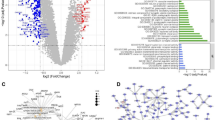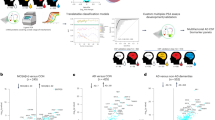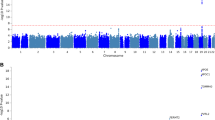Abstract
The immune response is highly active in Alzheimer’s disease (AD). Identification of genetic risk contributed by immune genes to AD may provide essential insight for the prognosis, diagnosis, and treatment of this neurodegenerative disease. In this study, we performed a genetic screening for AD-related top immune genes identified in Europeans in a Chinese cohort, followed by a multiple-stage study focusing on Complement Factor H (CFH) gene. Effects of the risk SNPs on AD-related neuroimaging endophenotypes were evaluated through magnetic resonance imaging scan, and the effects on AD cerebrospinal fluid biomarkers (CSF) and CFH expression changes were measured in aged and AD brain tissues and AD cellular models. Our results showed that the AD-associated top immune genes reported in Europeans (CR1, CD33, CLU, and TREML2) have weak effects in Chinese, whereas CFH showed strong effects. In particular, rs1061170 (Pmeta=5.0 × 10−4) and rs800292 (Pmeta=1.3 × 10−5) showed robust associations with AD, which were confirmed in multiple world-wide sample sets (4317 cases and 16 795 controls). Rs1061170 (P=2.5 × 10−3) and rs800292 (P=4.7 × 10−4) risk-allele carriers have an increased entorhinal thickness in their young age and a higher atrophy rate as the disease progresses. Rs800292 risk-allele carriers have higher CSF tau and Aβ levels and severe cognitive decline. CFH expression level, which was affected by the risk-alleles, was increased in AD brains and cellular models. These comprehensive analyses suggested that CFH is an important immune factor in AD and affects multiple pathological changes in early life and during disease progress.
Similar content being viewed by others
Log in or create a free account to read this content
Gain free access to this article, as well as selected content from this journal and more on nature.com
or
References
Abecasis GR, Auton A, Brooks LD, DePristo MA, Durbin RM, Handsaker RE et al (2012). An integrated map of genetic variation from 1,092 human genomes. Nature 491: 56–65.
Alzheimer's Association (2013). 2013 Alzheimer's disease facts and figures. Alzheimers Dement 9: 208–245.
Ansari M, McKeigue PM, Skerka C, Hayward C, Rudan I, Vitart V et al (2013). Genetic influences on plasma CFH and CFHR1 concentrations and their role in susceptibility to age-related macular degeneration. Hum Mol Genet 22: 4857–4869.
Baker ML, Wang JJ, Rogers S, Klein R, Kuller LH, Larsen EK et al (2009). Early age-related macular degeneration, cognitive function, and dementia: the Cardiovascular Health Study. Arch Ophthalmol 127: 667–673.
Bergamaschini L, Rossi E, Vergani C, De Simoni MG (2009). Alzheimer's disease: another target for heparin therapy. Sci World J 9: 891–908.
Bertram L, McQueen MB, Mullin K, Blacker D, Tanzi RE (2007). Systematic meta-analyses of Alzheimer disease genetic association studies: the AlzGene database. Nat Genet 39: 17–23.
Bi R, Zhang W, Yu D, Li X, Wang HZ, Hu QX et al (2015). Mitochondrial DNA haplogroup B5 confers genetic susceptibility to Alzheimer's disease in Han Chinese. Neurobiol Aging 36: 1604.e7.
Bi R, Zhao L, Zhang C, Lu W, Feng JQ, Wang Y et al (2014). No association of the LRRK2 genetic variants with Alzheimer's disease in Han Chinese individuals. Neurobiol Aging 35: 444.e5.
Blalock EM, Geddes JW, Chen KC, Porter NM, Markesbery WR, Landfield PW (2004). Incipient Alzheimer's disease: microarray correlation analyses reveal major transcriptional and tumor suppressor responses. Proc Natl Acad Sci USA 101: 2173–2178.
Clark SJ, Perveen R, Hakobyan S, Morgan BP, Sim RB, Bishop PN et al (2010). Impaired binding of the age-related macular degeneration-associated complement factor H 402H allotype to Bruch's membrane in human retina. J Biol Chem 285: 30192–30202.
Colantuoni C, Lipska BK, Ye T, Hyde TM, Tao R, Leek JT et al (2011). Temporal dynamics and genetic control of transcription in the human prefrontal cortex. Nature 478: 519–523.
Crehan H, Hardy J, Pocock J (2012). Microglia, Alzheimer's disease, and complement. Int J Alzheimers Dis 2012: 983640.
DiBattista AM, Stevens BW, Rebeck GW, Green AE (2014). Two Alzheimer's disease risk genes increase entorhinal cortex volume in young adults. Front Hum Neurosci 8: 779.
Donix M, Burggren AC, Scharf M, Marschner K, Suthana NA, Siddarth P et al (2013). APOE associated hemispheric asymmetry of entorhinal cortical thickness in aging and Alzheimer's disease. Psychiatry Res 214: 212–220.
Dunckley T, Beach TG, Ramsey KE, Grover A, Mastroeni D, Walker DG et al (2006). Gene expression correlates of neurofibrillary tangles in Alzheimer's disease. Neurobiol Aging 27: 1359–1371.
Ferreira VP, Pangburn MK, Cortes C (2010). Complement control protein factor H: the good, the bad, and the inadequate. Mol Immunol 47: 2187–2197.
Filippini N, MacIntosh BJ, Hough MG, Goodwin GM, Frisoni GB, Smith SM et al (2009). Distinct patterns of brain activity in young carriers of the APOE-epsilon4 allele. Proc Natl Acad Sci U S A 106: 7209–7214.
Gezen-Ak D, Dursun E, Hanagasi H, Bilgic B, Lohman E, Araz OS et al (2013). BDNF, TNFalpha, HSP90, CFH, and IL-10 serum levels in patients with early or late onset Alzheimer's disease or mild cognitive impairment. J Alzheimers Dis 37: 185–195.
Gogtay N, Giedd JN, Lusk L, Hayashi KM, Greenstein D, Vaituzis AC et al (2004). Dynamic mapping of human cortical development during childhood through early adulthood. Proc Natl Acad Sci USA 101: 8174–8179.
Hamilton G, Proitsi P, Williams J, O'Donovan M, Owen M, Powell J et al (2007). Complement factor H Y402H polymorphism is not associated with late-onset Alzheimer's disease. Neuromolecular Med 9: 331–334.
Harris JA, Devidze N, Verret L, Ho K, Halabisky B, Thwin MT et al (2010). Transsynaptic progression of amyloid-beta-induced neuronal dysfunction within the entorhinal-hippocampal network. Neuron 68: 428–441.
Higgins JP, Thompson SG (2002). Quantifying heterogeneity in a meta-analysis. Stat Med 21: 1539–1558.
Honda S, Itoh F, Yoshimoto M, Ohno S, Hinoda Y, Imai K (2000). Association between complement regulatory protein factor H and AM34 antigen, detected in senile plaques. J Gerontol A Biol Sci Med Sci 55: M265–M269.
Hye A, Lynham S, Thambisetty M, Causevic M, Campbell J, Byers HL et al (2006). Proteome-based plasma biomarkers for Alzheimer's disease. Brain 129: 3042–3050.
Hye A, Riddoch-Contreras J, Baird AL, Ashton NJ, Bazenet C, Leung R et al (2014). Plasma proteins predict conversion to dementia from prodromal disease. Alzheimers Dement 10: 799–807, e792.
Kaarniranta K, Salminen A, Haapasalo A, Soininen H, Hiltunen M (2011). Age-related macular degeneration (AMD): Alzheimer's disease in the eye? J Alzheimers Dis 24: 615–631.
Kadish I, Thibault O, Blalock EM, Chen KC, Gant JC, Porter NM et al (2009). Hippocampal and cognitive aging across the lifespan: a bioenergetic shift precedes and increased cholesterol trafficking parallels memory impairment. J Neurosci 29: 1805–1816.
Kamer AR (2010). Systemic inflammation and disease progression in Alzheimer disease. Neurology 74: 1157.
Karch CM, Goate AM (2015). Alzheimer's disease risk genes and mechanisms of disease pathogenesis. Biol Psychiatry 77: 43–51.
Keenan TD, Goldacre R, Goldacre MJ (2014). Associations between age-related macular degeneration, Alzheimer disease, and dementia: record linkage study of hospital admissions. JAMA Ophthalmol 132: 63–68.
Khan UA, Liu L, Provenzano FA, Berman DE, Profaci CP, Sloan R et al (2014). Molecular drivers and cortical spread of lateral entorhinal cortex dysfunction in preclinical Alzheimer's disease. Nat Neurosci 17: 304–311.
Klein RJ, Zeiss C, Chew EY, Tsai JY, Sackler RS, Haynes C et al (2005). Complement factor H polymorphism in age-related macular degeneration. Science 308: 385–389.
Lambert JC, Ibrahim-Verbaas CA, Harold D, Naj AC, Sims R, Bellenguez C et al (2013). Meta-analysis of 74,046 individuals identifies 11 new susceptibility loci for Alzheimer's disease. Nat Genet 45: 1452–1458.
Le Fur I, Laumet G, Richard F, Fievet N, Berr C, Rouaud O et al (2010). Association study of the CFH Y402H polymorphism with Alzheimer's disease. Neurobiol Aging 31: 165–166.
Li J, Cui Y, Wu K, Liu B, Zhang Y, Wang C et al (2015). The cortical surface area of the insula mediates the effect of DBH rs7040170 on novelty seeking. Neuroimage 117: 184–190.
Lu T, Pan Y, Kao SY, Li C, Kohane I, Chan J et al (2004). Gene regulation and DNA damage in the ageing human brain. Nature 429: 883–891.
O'Dwyer L, Lamberton F, Matura S, Tanner C, Scheibe M, Miller J et al (2012). Reduced hippocampal volume in healthy young ApoE4 carriers: an MRI study. PLoS One 7: e48895.
Ormsby RJ, Ranganathan S, Tong JC, Griggs KM, Dimasi DP, Hewitt AW et al (2008). Functional and structural implications of the complement factor H Y402H polymorphism associated with age-related macular degeneration. Invest Ophthalmol Vis Sci 49: 1763–1770.
Patel D, Henry J, Good T (2006). Attenuation of beta-amyloid induced toxicity by sialic acid-conjugated dendrimeric polymers. Biochim Biophys Acta 1760: 1802–1809.
Pham TQ, Kifley A, Mitchell P, Wang JJ (2006). Relation of age-related macular degeneration and cognitive impairment in an older population. Gerontology 52: 353–358.
Proitsi P, Lupton MK, Dudbridge F, Tsolaki M, Hamilton G, Daniilidou M et al (2012). Alzheimer's disease and age-related macular degeneration have different genetic models for complement gene variation. Neurobiol Aging 33: 1843.e9.
Purcell S, Neale B, Todd-Brown K, Thomas L, Ferreira MA, Bender D et al (2007). PLINK: a tool set for whole-genome association and population-based linkage analyses. Am J Hum Genet 81: 559–575.
Querfurth HW, LaFerla FM (2010). Alzheimer's disease. N Engl J Med 362: 329–344.
Ramasamy A, Trabzuni D, Guelfi S, Varghese V, Smith C, Walker R et al (2014). Genetic variability in the regulation of gene expression in ten regions of the human brain. Nat Neurosci 17: 1418–1428.
Ritchie MD, Hahn LW, Roodi N, Bailey LR, Dupont WD, Parl FF et al (2001). Multifactor-dimensionality reduction reveals high-order interactions among estrogen-metabolism genes in sporadic breast cancer. Am J Hum Genet 69: 138–147.
Shaw P, Lerch JP, Pruessner JC, Taylor KN, Rose AB, Greenstein D et al (2007). Cortical morphology in children and adolescents with different apolipoprotein E gene polymorphisms: an observational study. Lancet Neurol 6: 494–500.
Sivak JM (2013). The aging eye: common degenerative mechanisms between the Alzheimer's brain and retinal disease. Invest Ophthalmol Vis Sci 54: 871–880.
Strang F, Scheichl A, Chen YC, Wang X, Htun NM, Bassler N et al (2012). Amyloid plaques dissociate pentameric to monomeric C-reactive protein: a novel pathomechanism driving cortical inflammation in Alzheimer's disease? Brain Pathol 22: 337–346.
Strohmeyer R, Ramirez M, Cole GJ, Mueller K, Rogers J (2002). Association of factor H of the alternative pathway of complement with agrin and complement receptor 3 in the Alzheimer's disease brain. J Neuroimmunol 131: 135–146.
Strohmeyer R, Shen Y, Rogers J (2000). Detection of complement alternative pathway mRNA and proteins in the Alzheimer's disease brain. Brain Res Mol Brain Res 81: 7–18.
Suh SW, Jensen KB, Jensen MS, Silva DS, Kesslak PJ, Danscher G et al (2000). Histochemically-reactive zinc in amyloid plaques, angiopathy, and degenerating neurons of Alzheimer's diseased brains. Brain Res 852: 274–278.
Thambisetty M, Hye A, Foy C, Daly E, Glover A, Cooper A et al (2008). Proteome-based identification of plasma proteins associated with hippocampal metabolism in early Alzheimer's disease. J Neurol 255: 1712–1720.
The GTEx Consortium (2013). The Genotype-Tissue Expression (GTEx) project. Nat Genet 45: 580–585.
Voight BF, Kudaravalli S, Wen X, Pritchard JK (2006). A map of recent positive selection in the human genome. PLoS Biol 4: e72.
Voineskos AN, Lerch JP, Felsky D, Shaikh S, Rajji TK, Miranda D et al (2011). The brain-derived neurotrophic factor Val66Met polymorphism and prediction of neural risk for Alzheimer disease. Arch Gen Psychiatry 68: 198–206.
Wang HZ, Bi R, Hu QX, Xiang Q, Zhang C, Zhang DF et al (2014). Validating GWAS-identified risk loci for Alzheimer's disease in Han Chinese populations. Mol Neurobiol. (doi:10.1007/s12035-014-9015-z).
Weiner MW, Aisen PS, Jack CR Jr, Jagust WJ, Trojanowski JQ, Shaw L et al (2010). The Alzheimer's disease neuroimaging initiative: progress report and future plans. Alzheimers Dement 6: 202–211 e207.
Wong WL, Su X, Li X, Cheung CM, Klein R, Cheng CY et al (2014). Global prevalence of age-related macular degeneration and disease burden projection for 2020 and 2040: a systematic review and meta-analysis. Lancet Glob Health 2: e106–e116.
Woo SJ, Park KH, Ahn J, Choe JY, Jeong H, Han JW et al (2012). Cognitive impairment in age-related macular degeneration and geographic atrophy. Ophthalmology 119: 2094–2101.
Wyss-Coray T (2006). Inflammation in Alzheimer disease: driving force, bystander or beneficial response? Nat Med 12: 1005–1015.
Zetterberg M, Landgren S, Andπersson ME, Palmer MS, Gustafson DR, Skoog I et al (2008). Association of complement factor H Y402H gene polymorphism with Alzheimer's disease. Am J Med Genet B Neuropsychiatr Genet 147B: 720–726.
Zhang DF, Wang D, Li YY, Yao YG (2014). Mapping genetic variants in the CFH gene for association with leprosy in Han Chinese. Genes Immun 15: 506–510.
Zhang J (2003). Evolution of the human ASPM gene, a major determinant of brain size. Genetics 165: 2063–2070.
Zhang X, Yu JT, Li J, Wang C, Tan L, Liu B et al (2015). Bridging Integrator 1 (BIN1) genotype effects on working memory, hippocampal volume, and functional connectivity in young healthy individuals. Neuropsychopharmacology 40: 1794–1803.
Acknowledgements
We thank Ian Logan for language editing and helpful comments and the three anonymous reviewers for their critical comments on the early version of the manuscript.
Author information
Authors and Affiliations
Consortia
Corresponding authors
Additional information
Supplementary Information accompanies the paper on the Neuropsychopharmacology website
Supplementary information
Rights and permissions
About this article
Cite this article
Zhang, DF., Li, J., Wu, H. et al. CFH Variants Affect Structural and Functional Brain Changes and Genetic Risk of Alzheimer’s Disease. Neuropsychopharmacol 41, 1034–1045 (2016). https://doi.org/10.1038/npp.2015.232
Received:
Revised:
Accepted:
Published:
Issue date:
DOI: https://doi.org/10.1038/npp.2015.232
This article is cited by
-
Associations of cerebrospinal fluid complement proteins with Alzheimer’s pathology, cognition, and brain structure in non-dementia elderly
Alzheimer's Research & Therapy (2024)
-
Alzheimer’s disease-associated complement gene variants influence plasma complement protein levels
Journal of Neuroinflammation (2023)
-
The complement cascade in Alzheimer’s disease: a systematic review and meta-analysis
Molecular Psychiatry (2021)
-
Neuroprotective effects of verbascoside against Alzheimer’s disease via the relief of endoplasmic reticulum stress in Aβ-exposed U251 cells and APP/PS1 mice
Journal of Neuroinflammation (2020)
-
Regional protein expression in human Alzheimer’s brain correlates with disease severity
Communications Biology (2019)



